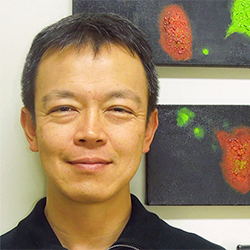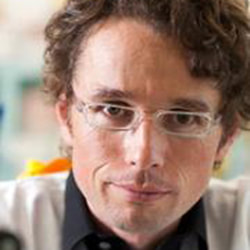Session 8
13 September 2022
4:30 - 6:00pm SGT (UTC+8)
5:30 - 7:00pm JST
6:30-8:00pm AEST
13 September 2022
4:30 - 6:00pm SGT (UTC+8)
5:30 - 7:00pm JST
6:30-8:00pm AEST
Abstract
IL-31 receptor blockade is a promising treatment strategy for chronic itch diseases. However, in vivo contributions of IL-31 receptor expressed by different cell types and the downstream JAK-STAT signaling pathway to the itch induction remain undetermined. My group has demonstarted that IL-31 receptor in sensory neurons but not in keratinocytes is required for the itch induction by IL-31. Surprisingly, unlike the previous report, our study indicated that the acute itch induction by an IL-31 injection as well as the chronic itch induction in the atopic dermatitis model was completely dependent on STAT3 in sensory neurons. Thus, our data reveal the pivotal roles for sensory neuronal IL-31 receptor and STAT3 in inflammatory itch.
IL-31 receptor blockade is a promising treatment strategy for chronic itch diseases. However, in vivo contributions of IL-31 receptor expressed by different cell types and the downstream JAK-STAT signaling pathway to the itch induction remain undetermined. My group has demonstarted that IL-31 receptor in sensory neurons but not in keratinocytes is required for the itch induction by IL-31. Surprisingly, unlike the previous report, our study indicated that the acute itch induction by an IL-31 injection as well as the chronic itch induction in the atopic dermatitis model was completely dependent on STAT3 in sensory neurons. Thus, our data reveal the pivotal roles for sensory neuronal IL-31 receptor and STAT3 in inflammatory itch.
Bio
1999: Ph.D., School of Life Science, Graduate University for Advanced Studies 1999-2002: JSPS Research Fellow, National Institute for Physiological Sciences 2002-2007: Postdoctoral Fellow, University of California, San Francisco 2007-2008: Associate Professor, Graduate School of Engineering, Kyoto University 2008-2013: Unit Leader, RIKEN Research Center for Allergy and Immunology 2013-present: Team Leader, RIKEN Center for Integrative Medical Sciences Adjunct Positions: Visiting Professor (2016-present), Grad School of Medical Life Science, Yokohama City Univ Visiting Professor (2020-present), Keio Univ School of Medicine
1999: Ph.D., School of Life Science, Graduate University for Advanced Studies 1999-2002: JSPS Research Fellow, National Institute for Physiological Sciences 2002-2007: Postdoctoral Fellow, University of California, San Francisco 2007-2008: Associate Professor, Graduate School of Engineering, Kyoto University 2008-2013: Unit Leader, RIKEN Research Center for Allergy and Immunology 2013-present: Team Leader, RIKEN Center for Integrative Medical Sciences Adjunct Positions: Visiting Professor (2016-present), Grad School of Medical Life Science, Yokohama City Univ Visiting Professor (2020-present), Keio Univ School of Medicine
Abstract
Despite the unprecedented success of targeted and immune therapies using MAPK pathway and immune checkpoint inhibitors (MAPKi, ICi), many patients with advanced melanoma still die due to drug resistance. Phenotypic intratumour heterogeneity (tumours are composed of cells or distinct cell clusters with different proliferation behaviour) and poor anti-tumour lymphocyte infiltration (e.g. cytotoxic T cells (CTL) or natural killer (NK) cells) are the main reasons for MAPKi and ICi resistance, respectively. We found microphthalmia-associated transcription factor (MITF) to control tumour mechanical properties which regulate phenotypic heterogeneity. Moreover, through altering tumour architecture, MITF may control immune cell infiltration. Consequently, targeting the MITF pathway can be exploited pharmacologically to improve targeted and immune therapies. Melanoma-related deaths are due to metastatic disease, highlighting the need for therapeutics which inhibit invasion. Cell navigation through the tumour stroma requires adaptive changes in cell and nuclear shape to fit matrix physical attributes in a process termed mechanosensing, for which microtubules play a pivotal role. Microtubule-binding proteins, CLASPs, are highly overexpressed in metastatic melanoma, where they regulate resistance of microtubules during melanoma invasion. Melanoma cells utilise CLASPs to drive invasion and survival. Thus, our findings suggest that CLASPs can be targeted to inhibit metastasis. In summary, understanding melanoma biology is utilised to develop novel melanoma therapies.
Despite the unprecedented success of targeted and immune therapies using MAPK pathway and immune checkpoint inhibitors (MAPKi, ICi), many patients with advanced melanoma still die due to drug resistance. Phenotypic intratumour heterogeneity (tumours are composed of cells or distinct cell clusters with different proliferation behaviour) and poor anti-tumour lymphocyte infiltration (e.g. cytotoxic T cells (CTL) or natural killer (NK) cells) are the main reasons for MAPKi and ICi resistance, respectively. We found microphthalmia-associated transcription factor (MITF) to control tumour mechanical properties which regulate phenotypic heterogeneity. Moreover, through altering tumour architecture, MITF may control immune cell infiltration. Consequently, targeting the MITF pathway can be exploited pharmacologically to improve targeted and immune therapies. Melanoma-related deaths are due to metastatic disease, highlighting the need for therapeutics which inhibit invasion. Cell navigation through the tumour stroma requires adaptive changes in cell and nuclear shape to fit matrix physical attributes in a process termed mechanosensing, for which microtubules play a pivotal role. Microtubule-binding proteins, CLASPs, are highly overexpressed in metastatic melanoma, where they regulate resistance of microtubules during melanoma invasion. Melanoma cells utilise CLASPs to drive invasion and survival. Thus, our findings suggest that CLASPs can be targeted to inhibit metastasis. In summary, understanding melanoma biology is utilised to develop novel melanoma therapies.
Bio
Nikolas Haass, MD/PhD/FACD Professor for Cutaneous Oncology/Principal Research Fellow Head, Experimental Melanoma Therapy Group Director of Higher Degree Research UQDI Academic lead of TRI’s Microscopy Facility Director of International Liaison and Past President of the Australasian Society for Dermatology Research (ASDR) Steering Committee Member of the Society for Melanoma Research (SMR) I am a clinician scientist and academic leader with research in melanoma cell biology and experimental melanoma therapy. I received my degree in medicine from the University of Heidelberg, Germany (1990-1998). I graduated summa cum laude with a PhD in Cell Biology from the University of Heidelberg (1993-1999) and trained in clinical dermatology at the University of Hamburg, Germany (1999-2003). In 2003 I moved to Philadelphia, PA, to work as a post-doctoral fellow in Meenhard Herlyn’s lab at The Wistar Institute (2003-2007). From there I was recruited as an associate faculty member at the Centenary Institute/University of Sydney (2007-2013). In 2013 I commenced a position as Associate Professor for Cutaneous Oncology at University of Queensland Diamantina Institute and was promoted to full Professor in April 2016. Using cutting-edge technology, including real-time cell cycle imaging in 3D culture and in vivo, my team studies the role of dynamic melanoma heterogeneity in melanomagenesis with the goal to develop novel therapeutic approaches by simultaneously targeting different tumour cell subpopulations. My laboratory and our team are in the unique position to combine sophisticated imaging and biosensor approaches with biochemical methods to provide unprecedented insight to the mechanisms of tumour heterogeneity, tumour-stroma interactions and cancer immunology.
Nikolas Haass, MD/PhD/FACD Professor for Cutaneous Oncology/Principal Research Fellow Head, Experimental Melanoma Therapy Group Director of Higher Degree Research UQDI Academic lead of TRI’s Microscopy Facility Director of International Liaison and Past President of the Australasian Society for Dermatology Research (ASDR) Steering Committee Member of the Society for Melanoma Research (SMR) I am a clinician scientist and academic leader with research in melanoma cell biology and experimental melanoma therapy. I received my degree in medicine from the University of Heidelberg, Germany (1990-1998). I graduated summa cum laude with a PhD in Cell Biology from the University of Heidelberg (1993-1999) and trained in clinical dermatology at the University of Hamburg, Germany (1999-2003). In 2003 I moved to Philadelphia, PA, to work as a post-doctoral fellow in Meenhard Herlyn’s lab at The Wistar Institute (2003-2007). From there I was recruited as an associate faculty member at the Centenary Institute/University of Sydney (2007-2013). In 2013 I commenced a position as Associate Professor for Cutaneous Oncology at University of Queensland Diamantina Institute and was promoted to full Professor in April 2016. Using cutting-edge technology, including real-time cell cycle imaging in 3D culture and in vivo, my team studies the role of dynamic melanoma heterogeneity in melanomagenesis with the goal to develop novel therapeutic approaches by simultaneously targeting different tumour cell subpopulations. My laboratory and our team are in the unique position to combine sophisticated imaging and biosensor approaches with biochemical methods to provide unprecedented insight to the mechanisms of tumour heterogeneity, tumour-stroma interactions and cancer immunology.
CHAIRS
Kim ROBINSON, A*STAR Skin Research Laboratories, Singapore
Takeshi MATSUI, RIKEN, Japan
Kim ROBINSON, A*STAR Skin Research Laboratories, Singapore
Takeshi MATSUI, RIKEN, Japan



